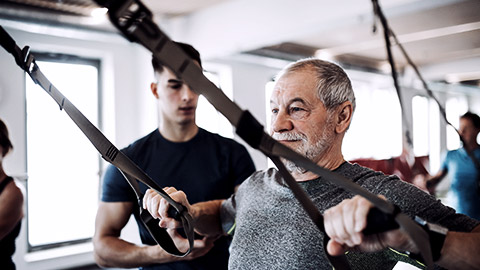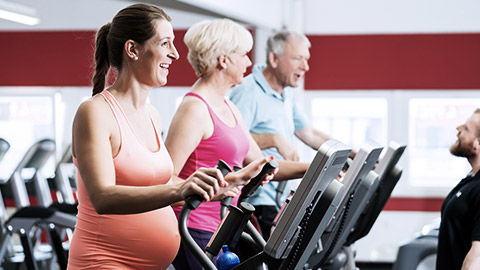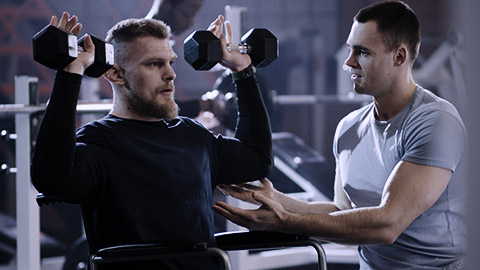Working in the fitness industry will expose you to all types of clients. As a trainer, it is important that you can apply best practices when dealing with many types of clients, including those that are special populations. Understanding the benefits exercise provides and how to mitigate risks will provide you with optimum coaching strategies when managing special populations.
Special population refers to individuals with specific health concerns or medical conditions requiring specialised exercise programming and supervision. These individuals may require modifications to their exercise programme or additional supervision to ensure their exercise routine is safe and effective. Special population clients may include individuals with:
- Cardiovascular disease
- Diabetes
- Arthritis
- Osteoporisis
- Athsma
As well as clients who are elderly, children, adolescents, pregnant, obese, or disabled.
In this topic, we’ll cover:
- Exercise benefits
- Barriers to exercise participation
- Exercise risks
- American College of Sports Medicine (ACSM) risk factor stratification

Regular exercise offers a wide range of physiological and psychological benefits for individuals. These benefits can include lowered blood pressure, improved sleep quality and mood, increased muscular strength, enhanced sporting performance, and more. For example, exercise has been shown to reduce the risk of developing chronic diseases such as heart disease, diabetes, and certain types of cancer. It can also improve cognitive function and reduce the symptoms of depression and anxiety.
Everybody benefits from moving around, including children, adolescents, young and middle-aged adults, older people, and those with health conditions and disabilities. Exercise is proven to improve the overall quality of life.
Exercise can provide numerous health benefits for special populations with unique health considerations, limitations, or requirements. Here are some examples:
- Improved cardiovascular health: Exercise can improve heart and lung function, reduce the risk of heart disease, lower blood pressure and cholesterol levels, and improve circulation.
- Improved physical function: Exercise can improve strength, endurance, flexibility, postural strength, and balance, benefiting special populations with limited mobility, physical impairments, or other disabilities.
- Reduced risk of chronic diseases: Exercise can reduce the risk of chronic diseases such as diabetes, heart disease, stroke, and some types of cancer, which can benefit special populations at higher risk due to genetic or lifestyle factors.
- Improved mental health: Exercise can reduce stress, anxiety, and depression, and improve mood and overall wellbeing. It also allows for greater social and recreational opportunities, positively impacting mental health.
- Improved cognitive function: Exercise can improve cognitive function, memory, and brain health and reduce the risk of cognitive decline, which can benefit special populations at higher risk of cognitive impairment due to age or health conditions. Creativity, productivity, and focus improve.
- Prevention of degenerative diseases: Exercise can help prevent or delay the onset of degenerative diseases such as Alzheimer's and Parkinson's disease, particularly in older adults.
- Maintenance of bone mass: Exercise can help maintain bone density and reduce the risk of osteoporosis and fractures, particularly in older adults and individuals with conditions that affect bone health.
- Reductions in total body fat, including visceral fat: Exercise can help reduce total body fat and visceral fat, which can benefit special populations who may be at higher risk of obesity-related health conditions.
- Strengthening of the immune system: Exercise can strengthen the immune system and reduce the risk of infections, particularly in special populations more susceptible to infections, such as older adults and individuals with chronic health conditions.
As you can see, exercise provides many health benefits for special populations. With those benefits, it is still important to consider barriers to exercise and to design exercise programmes that are safe and appropriate for each individual's unique needs and limitations. Seek guidance from a healthcare professional or experienced fitness professional when a special population is outside your scope of practice, high-risk, or new to you.
Watch
A study from the University of Florida showed significant evidence that physical activity improves the independence and mobility of older adults. Watch the video to learn more.
Every person not involved in regular physical activity has reasons, or barriers, to participation. For many clients, maintaining a regular exercise routine can be a challenge. However, for special populations, there may be unique barriers that make it even more difficult to engage in physical activity. The reasons for not exercising are not always medical, but the medical reason adds to the problem that you, as a trainer, have to help your client overcome.
Can you name some common reasons people give for not exercising?
Barriers are things that may stop an individual from participating in recreation. Many of these barriers exist, preventing all kinds of people from participating. Barriers can be divided into 3 major categories:
- Intrapersonal (internal)
- Interpersonal (external)
- Structural (physical and external)
Intrapersonal barriers
Intrapersonal barriers are internal psychological barriers. They could include barriers such as a lack of knowledge of what is needed or of exercises, being too scared to get to a gym because they’ll be judged, internalising and overanalysing situations, thinking they’re too unhealthy to start, questioning themselves a lot, and they’re often scared.
Interpersonal barriers
These block interactions between the individual and his or her social environment. This could include things like:
- The attitude of the other participants towards them and others' willingness to accommodate the client
- A lack of role models to gain motivation from
- Prior negative experiences fitting in with others
- Physical or communication disabilities
- Lack of support, e.g., a client's partner that doesn't want them to go to the gym or use a personal trainer
Do not judge. As a personal trainer, you must have an unbiased and non-judgemental approach.
Attitudinal barriers can be the most challenging barriers to overcome because they involve personal beliefs, attitudes, and values that can be deeply ingrained. The 3 types of attitudinal barriers are:
- Negative behaviours: "I don't want to..."
- Paternalistic behaviours: "I don't want you..."
- Apathetic behaviours: "I don't care..."
These are common examples of how personal attitudes can limit a person's willingness or ability to engage in physical activity.
Negative behaviours involve thoughts or statements such as "I don't want to," which can reflect a lack of motivation, interest, or self-efficacy related to exercise. Paternalistic behaviours involve statements such as "I don't want you," which can reflect a lack of trust or confidence in others, such as healthcare professionals or fitness instructors, to guide and support them in their exercise programme. Apathetic behaviours involve thoughts or statements such as "I don't care," which can reflect a lack of importance or value placed on exercise or physical activity.
Overcoming attitudinal barriers requires a shift in personal beliefs and attitudes toward exercise. This may involve education, encouragement, and support from healthcare professionals, family members, friends, or fitness professionals. Helping individuals find meaning, value, and purpose in exercise can also help shift their attitudes and beliefs toward physical activity.
Structural barriers
These barriers refer to environmental or systemic factors that make it difficult or impossible for individuals to engage in physical activity. Here are some examples of common structural barriers to exercise:
- Limited access to exercise facilities: This can include a lack of gyms or fitness centres in a neighbourhood or limited availability of specialised equipment or programmes for special population clients.
- Lack of public transportation: This can make it difficult for individuals to access exercise facilities or outdoor recreational spaces, particularly for those who live in rural areas or have limited mobility.
- Safety concerns: This can include concerns about crime or personal safety in outdoor spaces or parks, or a lack of well-lit areas or safe walking or biking paths.
- Cost: This can include the cost of gym memberships, specialised equipment, or professional guidance, which can be a financial burden for many individuals.
- Lack of time: This can include a lack of time due to work, family responsibilities, or other obligations, making it difficult to prioritise exercise.
- Environmental factors: This can include extreme weather conditions, such as heat, cold, or air pollution, limiting outdoor exercise options.
- Social and cultural factors: This can include cultural norms or expectations related to exercise or gender, which can impact individuals' willingness or ability to engage in physical activity.
Addressing structural barriers to exercise often requires changes at the community or policy level, such as improving access to affordable exercise facilities, increasing public transportation options, or creating safe outdoor spaces. However, individuals can also take steps to overcome structural barriers by finding creative ways to exercise within their environment, seeking out low-cost or free exercise options, or finding support and motivation from family members, friends, or community groups.
Some common barriers

The following table shows examples of common barriers for 3 special population groups.
| Examples of special populations | Examples of possible barriers |
|---|---|
| Elderly clients |
|
| Pregnant clients |
|
| Clients with disabilities |
|
Despite these barriers, clients in these special populations need to prioritise physical activity as it can improve overall health and wellbeing.
Finding the right types of exercise and modifications can make all the difference in overcoming these barriers and achieving a successful fitness routine and aid in improving your clients' confidence in themselves.

Special population clients may be at an increased risk for certain injuries or complications during exercise, making it important for exercise professionals to be aware of potential risks and have a plan to minimise risk.
By developing a safe and effective training environment and routine, exercise professionals can help ensure that all clients, including those in special populations, can participate in physical activity in a way that prioritises their health and wellbeing.
Exercise comes with certain risks that can be influenced by factors such as:
- The physical nature of the exercise
- The training environment, including locations, facilities, and conditions of the training environment
- The lack of technical expertise available from clients or coaches
- Poor biomechanics of clients
Special populations may face unique risks when engaging in exercise routines, including the following:
- Impact injuries
- Fractures and dislocations
- Spinal injuries
- Cardiac and or cerebrovascular injuries
- General musculoskeletal injuries
- Special conditions, such as induced bronchospasms within asthmatic clients
Conducting a comprehensive pre-exercise screening and consultation with potential clients is essential. This allows you to gather information about their medical history, current health status, and any medications they may be taking. By assessing this information, you can determine if your qualifications and expertise align with the client's needs and if you can support them in achieving their health and fitness goals.
Remember, you have a duty of care to those you work with and an ethical responsibility to work within your scope of practice. Should you feel that you are not confident or not yet competent to work with a particular client, be honest and discuss your concerns with your manager, who will guide you on the best practice approach that should be followed in these situations.
Cardiovascular disease (CVD)
Given that you are relatively new to the fitness industry and training, it would be unwise to place you in a position (at this stage) that would place the sole responsibility of a diagnosed CVD sufferer’s training in your hands.
For that reason, any student who wishes to work with a diagnosed CVD patient or high-risk client must clear this with the tutor before proceeding with the assessment.
Risk factors for cardiovascular disease
The following are some, not all, of the risk factors for cardiovascular disease. This information should be collected during the pre-screening stage as part of the client consultation. It is important to be aware of these to be able to attempt to recognise when a client may need programme adjustment, extra supervision of exercises or referral to a health professional such as their GP.
- Family history
- Smoker
- Hypertension (high blood pressure)
- High cholesterol
- Diabetes
- Obesity
- Sedentary lifestyle
Major signs and symptoms suggestive of cardiovascular/pulmonary disease
The following is a list of some of the signs and symptoms that a client with cardiovascular or pulmonary disease may be suffering from. Should a client present any of these during a session, cease activity and determine the appropriate next steps. Consult with your gym manager or a more experienced trainer, remember your first aid training, your duty of care, and your scope of practice. Always consult with your client and explain that a referral to an allied health professional may be necessary.
- Pain and or discomfort in areas such as the chest, neck, jaw or arms, which may be due to ischemia (restricted blood supply, resulting in a decreased oxygen supply to tissues of the body)
- Shortness of breath at rest of with mild exertion
- Dizziness
- Ankle oedema (excess fluid build-up/retention)
- Diagnosed heart murmur
- Unusual fatigue or shortness of breath during usual activities.
These risk factors and signs and symptoms indicate various events occurring within an individual’s system. Each one of these has contra-indications (factors that would cause exercise to be modified or ceased). It is vitally important that you perform a thorough pre-screening session during your client consultation.
Pre-screening is designed to ensure you capture all the past and current conditions, illnesses, injuries, and medications your client may have experienced to build a complete picture of your client and ensure your training session is safe and effective. This is not a one-time event. Should you feel your client is showing signs and symptoms you have not previously witnessed or been informed of, feel free to conduct another pre-screening session to ensure you have the most up-to-date information about the current health status of your client.
Should you feel your client presents with information that makes you uncertain of how to work safely together, you have a duty of care to do the best by your client, refer to an allied health professional such as a General Practitioner (GP) or another health professional for further advice.
Watch
Many clients with cardiovascular disease may fear exercising and triggering another event. Exercise can be done safely with appropriate exercise prescription, supervision, and medical support.
The American College of Sports Medicine (ACSM) is an association of 50,000 members strong from 90 countries around the globe. They represent 70 occupations within the field of sports medicine field ranging from academics, students, personal trainers, physicians, scientists and health and fitness professionals. They aim to “integrate scientific research to provide practical applications of exercise science and sports medicine.” With this in mind, ACSM provides many industry-standard tools that health and fitness industry members use worldwide.
ACSM provides guidelines for pre-screening clients: Exercise Participation Health Screening Recommendations.
Further information for exercise professionals regarding preparticipation screening:
What is a risk factor?
A risk factor is anything that increases the likelihood of adverse effects, specifically regarding exercise. These factors may cause symptoms that could affect a client's safety during and after training. Trainers must be aware of risk factors and their associated symptoms.
Modifiable versus non-modifiable risk factors
It's important to be aware of which risk factors can and cannot be modified to effectively and safely support clients. Look at the following table, which outlines which factors can and cannot be modified.
| MODIFIABLE RISK FACTORS | NON-MODIFIABLE RISK FACTORS |
|---|---|
|
|
